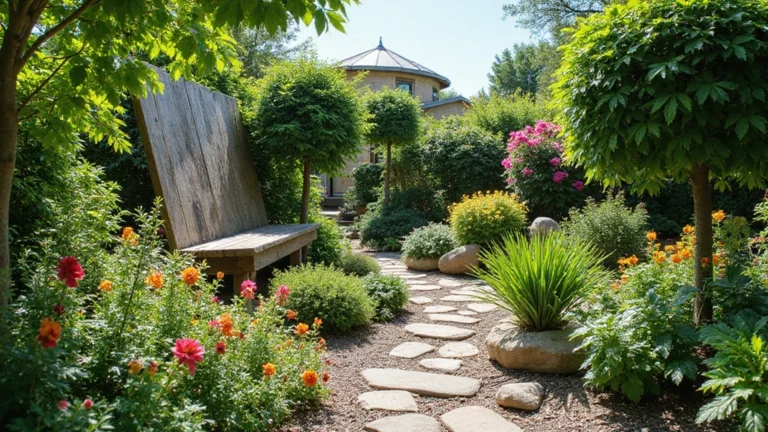21 Cottage Garden Design Ideas: Create Your Own Storybook Sanctuary
Ever walked past one of those dreamy, flower-filled gardens and thought, “Why doesn’t my yard look like that?” Don’t worry—you’re not alone.
Cottage gardens have that magical mix of wild beauty, rustic charm, and “organized chaos” that makes them look effortlessly stunning (even though, IMO, there’s definitely some behind-the-scenes magic going on).
If you’ve ever wanted to bring that fairytale feel to your outdoor space, you’re in the right place.
Grab a cup of tea, and let’s chat about 21 cottage garden design ideas that’ll make your garden feel like something out of The Secret Garden—minus the drama and hidden keys.
1. Embrace the Wild (But Make It Intentional)
Cottage gardens thrive on the “beautiful mess” aesthetic. Forget symmetry—think abundance, variety, and a touch of chaos.
Mix tall flowers with ground covers and shrubs. Let things grow together naturally.
Pro tip: Layer your plants like a floral lasagna—tall ones (like foxgloves and hollyhocks) at the back, medium bloomers (like lavender and daisies) in the middle, and low-growers (like creeping thyme) upfront.
2. Choose Classic Cottage Plants
You can’t call it a cottage garden without the classics:
- Roses (especially climbing varieties)
- Lavender (for scent and structure)
- Delphiniums (for height and color drama)
- Peonies (because who doesn’t love them?)
- Foxgloves (hello, fairytale vibes!)
These flowers bring that “plucked from a storybook” look instantly.
3. Add a Weathered Fence
There’s something ridiculously charming about an old picket fence. A weathered wooden fence or low stone wall instantly gives your garden that rustic edge.
Don’t repaint it—let nature do the decorating. A few ivy tendrils crawling over? Perfect.
4. Mix Colors Like You Don’t Care (Because You Don’t)
One of the joys of cottage gardening is breaking the rules. Go ahead and mix pinks, purples, yellows, and whites.
Nature doesn’t worry about color palettes, and neither should you.
FYI: If you’re nervous about clashing colors, pick one or two dominant tones (like pink and purple) and sprinkle in neutrals like white or pale yellow to balance things out.
5. Go Heavy on Fragrance
A cottage garden should smell as magical as it looks. Plant fragrant blooms near pathways or seating areas so you catch a whiff every time you walk by.
Lavender, sweet peas, honeysuckle, and jasmine are all winners.
Ever noticed how a good garden can lift your mood just through scent? That’s not imagination—science backs it up.
Smelling certain blooms actually triggers feel-good hormones. Nature therapy, anyone?
6. Let the Pathways Wander
Straight paths? Boring. Curved, meandering pathways invite exploration and give your garden that secret, whimsical feel.
Use gravel, cobblestone, or even stepping stones surrounded by moss or thyme for that authentic cottage vibe.
7. Add a Garden Arch or Arbor
An arch covered in roses or clematis? Yes, please.
It’s one of those features that screams “English countryside.” It also gives height and structure to an otherwise overflowing space.
Pro tip: Paint your arbor white or pale green for that traditional charm, or leave it untreated for a more rustic look.
8. Include a Cozy Seating Area
All that beauty deserves to be enjoyed. Create a nook with a weathered bench, bistro table, or wicker chair.
Add a few outdoor cushions, a throw, and maybe a cup of tea—you’ve just built yourself a sanctuary.
And yes, it’s totally fine if the bench looks like it’s been there for decades. That’s part of the charm.
9. Welcome the Bees and Butterflies
Cottage gardens are pollinator paradises. Choose nectar-rich flowers like coneflowers, cosmos, phlox, and daisies.
You’ll not only help the planet but also add a living, fluttering charm to your garden.
Plus, watching bees do their thing? Weirdly relaxing.
10. Add Rustic Garden Decor
A few well-chosen accents can elevate your garden from “cute” to “storybook perfection.” Think:
- Vintage watering cans
- Iron birdbaths
- Weathered terracotta pots
- Stone statues or fairy figurines
Just don’t overdo it—you want “rustic charm,” not “yard sale explosion.”
11. Plant in Layers, Not Lines
Cottage gardens aren’t military parades. They’re a joyful jumble of textures and heights.
Group plants in odd numbers (3, 5, or 7) to make arrangements look more natural.
And honestly? The less you try to control it, the better it usually turns out.
12. Incorporate Edible Plants
Who says beauty and practicality can’t coexist? Mix herbs, veggies, and edible flowers right in with your blooms.
Rosemary hedges, lettuce borders, and nasturtiums add texture and flavor.
Plus, you get to brag when someone compliments your garden—“Oh, that’s not just pretty; it’s dinner.” 😉
13. Use Containers Creatively
No garden space? No problem. Cottage gardens thrive in pots, baskets, and window boxes.
Try mismatched terracotta pots filled with petunias, geraniums, or herbs.
Even an old wooden crate or tin bucket can become an instant cottage planter (bonus points if it’s slightly dented).
14. Add Climbing Plants Everywhere
Walls, fences, trellises—basically any vertical surface deserves a vine. Climbing roses, ivy, wisteria, and clematis add drama, fragrance, and a soft, romantic touch.
There’s nothing quite like a cascade of wisteria in spring—it’s pure magic.
15. Create a Wildflower Meadow Patch
If you have space, leave a little section of your garden “untamed.” Scatter wildflower seeds and let nature take over.
It’s low-maintenance, eco-friendly, and incredibly beautiful.
It’s also the best excuse ever for skipping a weekend of weeding. You’re not being lazy—you’re “promoting biodiversity.” 😉
16. Add Water for Calm
A small pond, birdbath, or even a repurposed barrel filled with water can create a sense of peace and reflection.
Water attracts birds, frogs, and dragonflies—turning your garden into a full-on nature show.
And let’s be honest—nothing beats that gentle trickle sound while you sip your morning coffee outside.
17. Go for Imperfection
Cottage gardens are all about imperfection. A crooked path, a mismatched pot, a few overgrown vines—it all adds to the story. Perfection looks sterile; character looks lived-in.
Think of your garden like an old book—creased pages and all.
18. Build a Rustic Gate or Entryway
A charming entryway sets the tone. A wooden or wrought-iron gate surrounded by climbing blooms instantly gives that “step into another world” feeling.
Add a small sign with your garden’s name if you want to go full cottagecore.
19. Add Lighting for Evening Magic
When the sun goes down, the magic doesn’t have to. String fairy lights through trees, tuck lanterns along pathways, or add solar lights near flowerbeds.
The glow against the blooms is chef’s kiss.
Bonus: You’ll impress your neighbors every time they peek over the fence.
20. Blend Old and New Elements
Cottage style isn’t about sticking to one era. Mix vintage finds with modern comforts—like a rustic bench beside sleek solar lights, or classic roses next to minimalist garden sculptures.
That mix of old soul meets new age keeps your garden feeling timeless, not dated.
21. Make It Personal
At the end of the day, your cottage garden should reflect you. Add details that make you smile: a painted birdhouse, a quirky garden gnome, or even a teacup planter.
Don’t worry about following every rule in the book. The best cottage gardens are built from love, not Pinterest perfection.
Final Thoughts
So there you have it—21 cottage garden design ideas to transform your space into a whimsical escape that feels straight out of a fairytale. Remember, the beauty of a cottage garden lies in its imperfection. It’s meant to look wild, lived-in, and a little bit unpredictable.
Gardening is kind of like life, isn’t it? Messy, colorful, occasionally chaotic—but absolutely beautiful when you stop trying to control every detail.
So, go on—grab your gloves, plant something a little too close to something else, and let your garden tell its own story. 🌸




